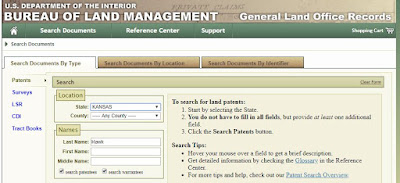John Hawk vs. Johnny Green Hawk and their sons:
George Washington Hawk vs. George Washington Hawk
Duplication of names is one thing, but this then leads to misattribution of families. This particular group I found quite upsetting for awhile. I could understand people taking my John Hawk genealogy and using it. After all, I listed my tree online around 1996 for that very reason. At that point I had been working on it for about 15 years and had even visited the home counties in West Virginia, Indiana, and Illinois. But more recently I started finding genealogical information for my John Hawk on records for a Johnny Green Hawk. I hadn't run across a middle name for my John.
To make matters worse, both men had sons named George Washington, both sons born in the 1820’s, and both ended up in Missouri. I think that’s where the trouble started! The father John G. Hawk also patented land in Missouri – more problems, but I’ve not found a Missouri record that linked to my John Hawk of Illinois. George Washington was a popular given name in those days, as many were named after the first POTUS. So finding many with that name wasn't upsetting. But when researchers started giving my great grandfather George W. Hawk two wives and two sets of children in two different counties at the same time, well, this was quite upsetting.
One day I stopped and questioned just what he (my G.W.) might have thought about all this. I didn’t know him, but something tells me he might find it amusing that anyone thought he had two families. It's helpful to think he might find it funny, but I can’t say I do! Then again, polygamy was an issue in those days so he might not appreciate it. He would probably be happy (and surprised) to know that he's remembered at all over 100 years after his death. I can't even imagine that.
More distressing, according to one researcher on ancestry, my great grandfather (my G.W.) even died in two different places many years apart. He first died in Missouri, and then apparently rose from the dead, and died later to be buried in Texas! That would really be something to brag about – if it had happened. I do understand how easy it is to grab that info from other trees, especially when we are new to ancestry.
Johnny Green Hawk might be more interesting study than my John Hawk, who was the farmer known in Christian County, Illinois as "the old Virginian." I found these entries from different researchers on rootsweb which helps to explain the Johnny Green Hawk and son G. W. genealogy:
- Hello. Thanks for the reply. I just spoke to my father and he told me (actually a whole lot of information!) that Green Hawk was a Geechie (sp.?) and came somewhere from the Carolinas. He also had 21 children from 2 marriages! My relation is through Ardless Benjamin Hawk Sr. Also, A.B's mother's name was LIA VONIA. My father was not too sure about the spelling of the last name, but that is what he gave me.
- I have a Johnny Green Hawk in my ancestry. I do not have birth or death dates or places. He had a son, George Washington Hawk, Sr. I do not know if G.W. had siblings. Geo. W. was born in 1820 in North Carolina and died bef. 1858 in Miller County, MO. He married Clarinda Boyd who was born in 1824 in Greenup County, KY. and died bef 1870 in Miller County, MO. They had children James D. Hawk, Robert Hawk, John R. Hawk, George W. Hawk, Jr. and my ancestor Mary Rahab Hawk. Mary was born Sep 6, 1844 in Miller County, MO. and died on Oct 1, 1909. Mary married John Grosvenor and their daughter Caroline was my great grandmother. Caroline married Renault C. Clark and their daughter Stella was my grandmother. Any of this sound familiar?
Well, at least that answered some questions about the mysterious Johnny Green Hawk.
So, should we talk about the several Jacob Hawks in Missouri? No? Okay, that can wait, although there’s a story there too!
The following is for anyone connecting with these families.
Additional Notes:
Mine: John Hawk, born Virginia 1824. This is my 2nd great grandfather. He married Margaret (Peggy) Groves in Hardy County. They left Hardy (now Grant) County, Virginia (now West Virginia) about 1838 and went to Tippecanoe County, Indiana. They lived in the southern part near the Montgomery County line. Before 1860 they moved to Christian County, Illinois, where Peggy died in 1858. Their oldest son was named George Washington Hawk. John then married Nancy Buskirk Kenneman, and they had one child, Dolly, born in 1861.
The other: John G. Hawk, aka Johnny Green Hawk: This may be the John G. Hawk who patented land in 1860 in Barry County, Missouri. Other than finding the rootsweb notes above I haven’t been able to find a lot about him, except he had also lived in Tennessee.
 My George Washington Hawk:
My George Washington Hawk: Born 1824 in
Hardy County, Virginia. Moved with family to
Tippecanoe County, Indiana where he married Salana Hudson, daughter of Josiah Hudson and Sarah Ann Cross of
Montgomery County, Indiana. They, George and Salana, moved to
Christian County,
Illinois, near his father, and later to
Nodaway County, Missouri. At various times four of George's brothers also lived there (Peter, Solomon, Jesse and Jacob). (My G.W. to the left.)
The other: George Washington Hawk, born either Tennessee or the Carolinas, was on the 1850 census in Osage County, Missouri. He married Clarinda Boyd in Miller County, Missouri and died before 1860. Clarinda was living in Miller County in 1860. I lose her after that.
So there it is for the record. If I do find proof that my great grandfather died twice I’ll be sure to let you know.














